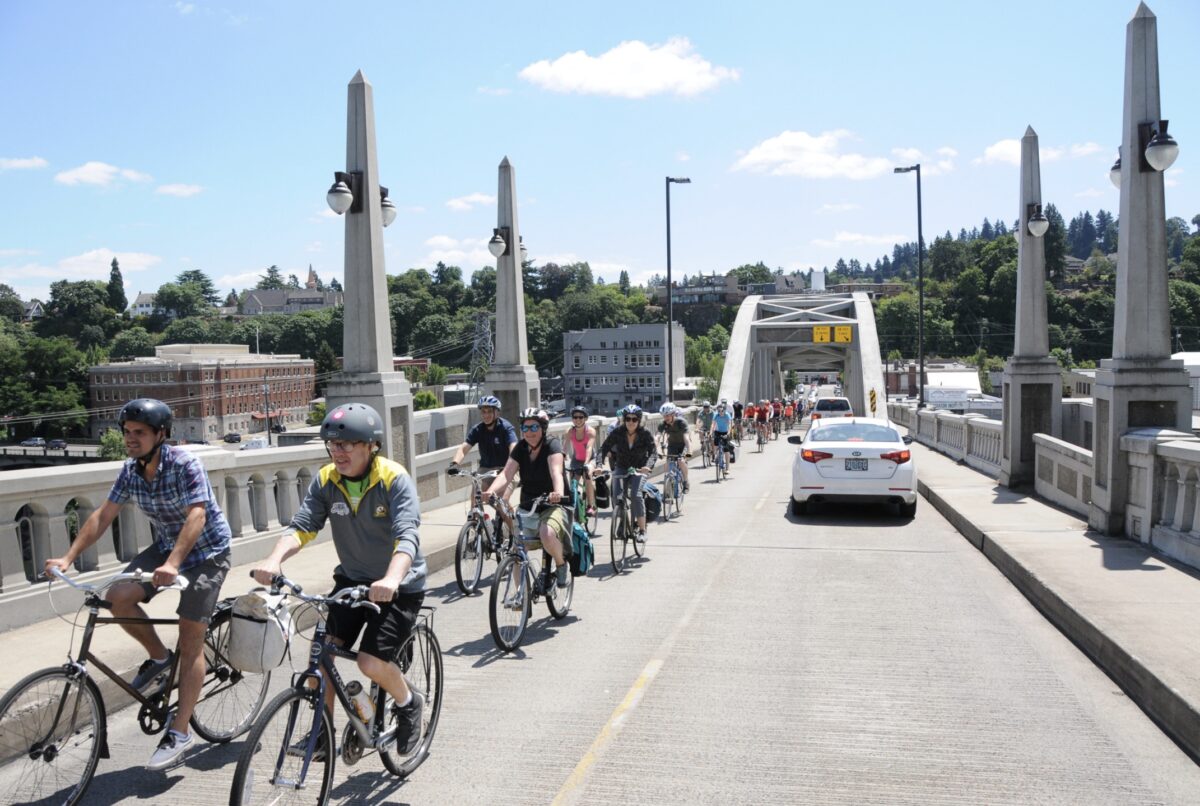
(Photos: Jonathan Maus/BikePortland)
On Thursday a Metro transportation advisory committee passed a resolution to explore the feasibility of a new carfree bridge over the Willamette River between Oregon City and West Linn.
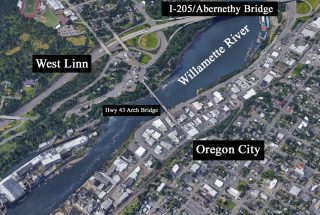
With $350,000 in federal funding, the Oregon Department of Transportation will lead the effort in partnership with the cities of West Linn and Oregon City, Clackamas County and Metro. Of the two bridges that currently cross the river, one of them is Interstate 205 (Abernethy Bridge, where cycling is prohibited) and the other is the narrow Arch Bridge that has no dedicated space for cycling.
The feasibility study will consider whether a new bridge is necessary and if so, what the ideal location would be. The options on the table are a new bridge south of the existing Arch Bridge, north of the existing bridge (and south of I-205/Abernethy Bridge), or to simply not build a new bridge and instead make the Arch Bridge carfree.
“The existing pedestrian/bicycle connection on the Oregon City Arch Bridge is narrow and steep for the pedestrians and cyclists to use the same narrow travel lanes as the vehicles on this historic bridge.”
— Kristen Stallman, ODOT
ODOT Major Projects Manager Kristen Stallman shared with me via email this morning that a more human-centric crossing is in line with other efforts to reclaim the Willamette River from years of neglect and industrial use. “This area is steeped with natural and cultural history and identifying a new bridge corridor will require coordination and comprehensive planning that leverages the visioning set in motion by both of these cities as they look to redevelop their waterfronts and connection to the Willamette River,” Stallman said.
A quiet and safe bridge for walkers, bicycle riders and rollers of all types would be a natural complement to the Willamette Falls Legacy Project which seeks to create a new riverwalk in coordination with The Confederated Tribes of Grand Ronde, who were displaced from the land by Oregon settlers in the late 19th century. The tribe’s sacred fishing and living grounds were replaced by paper and timber mills that have sat mostly idle for decades.
Advertisement

Here’s more from the Metro Staff Report:
This planning effort supports community desires to connect the regional active transportation network in this area. The existing Arch Bridge (OR 43) does not adequately serve bicycle and pedestrian connectivity within the vicinity. The planned I-205 Abernethy bridge will not allow bicycle and pedestrian use. Further, agency partners are interested in identifying a new option for a low stress connection between the two cities… A new pedestrian and bicycle bridge will enhance access for people walking and biking and provide the region opportunities to reconnect with the river and identify a key missing connection in the regional bikeway and pedestrian system. Completing the active transportation network with a bridge creates essential access to and along the Willamette River between Gladstone, Oregon City, and West Linn.
It’s worth noting that ODOT is currently planning to widen the Abernethy Bridge as part of a $500 million project on I-205. Some members of ODOT’s Bicycle and Pedestrian Advisory Committee (OBPAC) have wondered whether ODOT is flouting the state’s Bike Bill (which requires a minimum investment and accommodation for bicycle users on all major highway reconstruction projects) by not building a parallel bike path. The committee estimates the bike paths would add $20 to $50 million to the cost of the project; but ODOT has said the expense is, “disproportionate to the use and need”. ODOT’s current proposal is to force bicycle riders to use highway shoulders which would be widened as part of the project. A nearby bridge for bike riders would get the OBPAC (and a potential Bike Bill lawsuit) off ODOT’s back.
In 2012 ODOT added sharrow pavement markings to the deck of the bridge. In July 2019 regional elected officials and policymakers (including Metro President Lynn Peterson) rode bicycles over the Arch Bridge as part of a day-long tour of the area.
“The partners recognize the existing pedestrian/bicycle connection on the Oregon City Arch Bridge is narrow and steep for the pedestrians and cyclists to use the same narrow travel lanes as the vehicles on this historic bridge,” Stallman added. She also said the public outreach process for the project will start very soon and that it will, “Hopefully result in a vision for an enhanced crossing of the Willamette River in an extremely important location and necessary next steps.”
— Jonathan Maus: (503) 706-8804, @jonathan_maus on Twitter and jonathan@bikeportland.org
— Get our headlines delivered to your inbox.
— Support this independent community media outlet with a one-time contribution or monthly subscription.


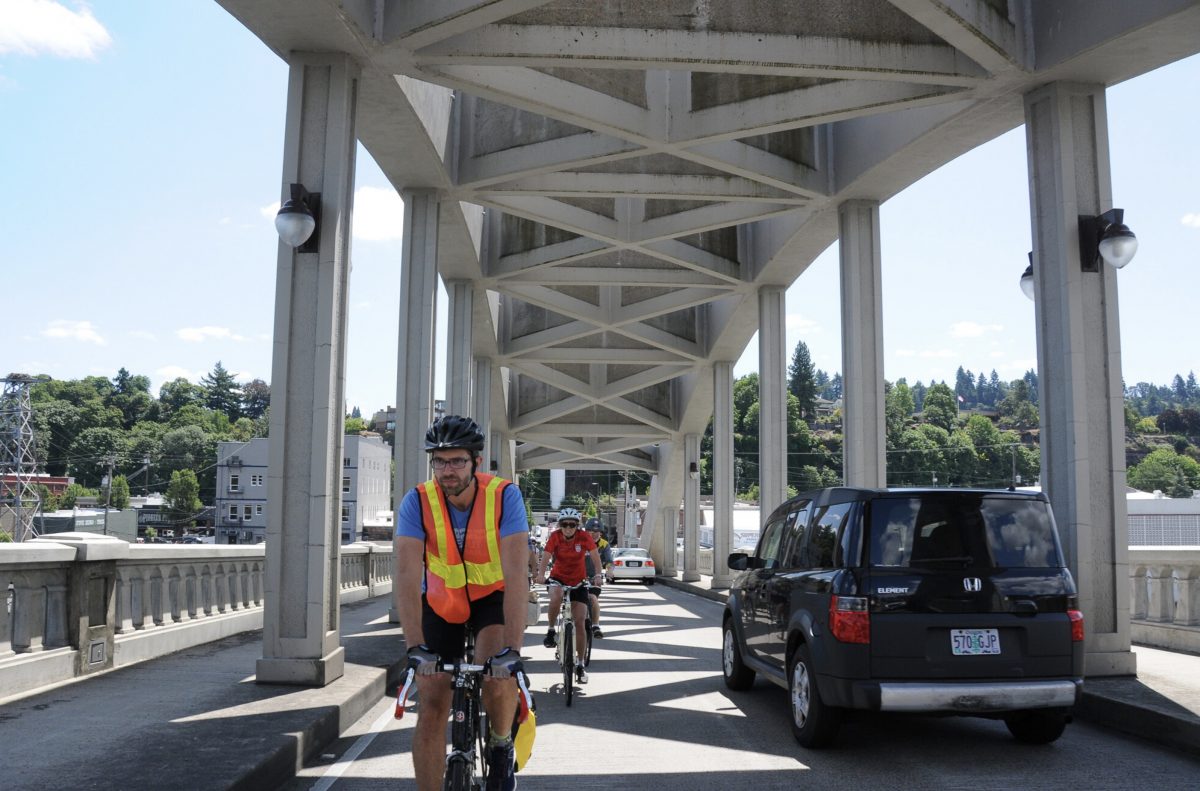



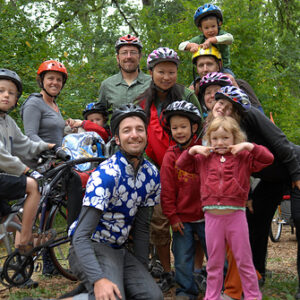
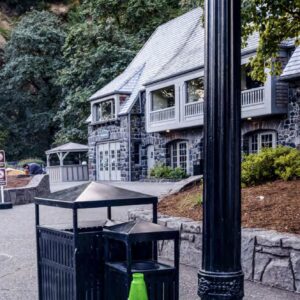
Thanks for reading.
BikePortland has served this community with independent community journalism since 2005. We rely on subscriptions from readers like you to survive. Your financial support is vital in keeping this valuable resource alive and well.
Please subscribe today to strengthen and expand our work.
Where is the “old BTA” when you need them?
Local advocates may need to dust off the history books…1990s…and start fundraising for a fight.
https://gettingto2100.org/portlands-bicycle-revolution-started-with-a-lawsuit/
Anyone familiar enough with the law to explain how ODOT can ignore ORS 366.514?
the old lawsuit that found that spending the $$ on planning was good enough. they don’t have to build, just spend $$. ugh.
The law seems to have the language “footpaths and trails,” which to me seems to mean separated infrastructure. Is there any reference to safety or physical separation to give it some teeth?
They can’t ignore it, but they can argue that they follow it. At that point someone must then take them to court.
I think the state legislature sets the spending amounts/percentages for automobile vs bike/pedestrians. Then the local transportation committees further set the priorities.
If they’re going to allow bikes to ride on the shoulders, I don’t think anything can be done. That technically just barely meets the bike bill requirements. It’s been done many times before.
It would be great, I just want the french prairie bridge, riding over I5 bridge is not nice
https://www.ci.wilsonville.or.us/engineering/page/french-prairie-bridge-project
Imagine being able to cycle down through West Linn along the river on a bike trail on the west side, over a dedicated bike / pedestrian bridge, then visiting Oregon Falls with no factory looming over them. That would be divine.
The existing bridge is basically perfect to just make car-free. It’s the narrowest point in the river. Clears over the highway on the OC side, great views… only downside is the West Linn side would need some improvements to connect from West Linn and/or Willamette areas better. A new bridge could be better if coupled with a expanded pathway under the 205 bridge however I’m sure it would not clear over 99 like the current bridge does and spit folks out at a super hostile crossing with the highway.
For cars this could actually be a benefit in simplifying the interchanges and resulting backups on the West Linn side. More simply routing all traffic to the interstate could do away with that terrible Willamette Falls Dr intersection in it’s current form. On the OC side it would help decongest the downtown side which has narrow streets and due to the prohibited left turn from the bridge causes lots of cut through traffic on what is basically an alleyway.
I rode across this bridge recently for the first time in a while and had forgotten what an awesome experience it is with the falls and cliffs with the old elevator right in front of you. Even the mill as unsightly as it is is impressive.
A bridge from Oak Grove to Lake Oswego is needed far more.
Yep, fully agree. There is no crossing for a 10 mile stretch of the Willamette from Sellwood to Oregon City… When the cemetery is locked at night there is no way to get home from Portland to Lake Oswego, or West Linn, without serious death defying feats.
Depending on your aversion to hills, your start and your destination, you could take Westlake > Jefferson Pkwy > Cervantes > Kerr Pkwy which leads to Barbur. It’s a delight 10-20% grade, but the 20% is only a tiny bit of it. Sure beats hwy 43.
How about a trail along the Willamette trolly ROW?
That’s actually the solution I’d prefer, use the ROW. Direct, flat, along the river, and away from traffic.
It’s somewhat ridable already if you’re not on a roadie. The trestles are mainly the problem.
I think I’d take big hills over trestles. My commuting bike is an wide tire sus-fork hybrid. So, I could do the trestles, if I was in a pinch.
In general though, I think if this idea was fleshed out (paved out?), it would help to fill in a big missing link. There’s sort of a black hole for cycling from sounth Portland to Lake Oswego. I can’t help but think that’s intentional. There’s a lot of murmuring that “Lake Oswego” doesn’t want bike. For every business they attract though, they “risk” exposure to cyclist traffic. Can’t really have it both ways. I do see a few commuters around LO though.
I’m not really familiar with the trolley ROW, is it anything like this?
The Willamette Shore Trolley shows up on the google map as railroad tracks. They are only used in the summer. It is a continuous downhill from LO. That map you gave is of the Oregon Electric Trolley which gave part of today’s Fanno Creek Trail. Near that map is also part of the Red Electric Trolley (someday part of the Red Electric Trail).
Is the Willamette Shore Trolley a defunct line? Seems like a no brainer to pave it if so. That would make so many people happy, new MUP.
Agreed. I had to look up what happened with that.
https://pamplinmedia.com/pt/9-news/449976-366643-lake-oswego-forces-bridge-study-out-of-city
Yeah, it sucks that the OGLO bridge concept seems to have died an undignified death at the hands of various NIMBYs.
Died because commissioners feared putting in this bridge would risk funding for the Sunrise Corridor Project. I remember one stating something along the lines of, “when people on bikes show up then we’ll build infrastructure, right now there is no demand for this bridge…”
Making the Arch Bridge car-free would solve the traffic diversion issue when they toll the Abernethy Bridge.
I don’t actually like the idea of making the arch bridge car-free, because that means even short car trips would have to use the freeway. Freeways are meant only for long trips, and it sucks when you have a lot of people hopping on at one exit and off at the next.
I would prefer a new ped/bike bridge somewhere between the arch bridge and the Willamette Falls. Imagine going over the bridge and having a perfect view of the falls, closer up than you get from the arch bridge today! And it would connect more directly the (eventually) redeveloped areas on either side where the mills used to be. So you can really design the approaches on either side to be really nice and bike-oriented.
If it’s a short trip, don’t drive?
Build a second bridge for car traffic near the arch bridge, and let the arch be for pedestrians and bikes. The existing bridge is dangerously narrow for cars anyway.
How about ODOT and Metro cancel the RQ project and use the $750 million savings to build a bunch of new bridges between Lake O and Oregon City – kill multiple birds with one stone?
Maybe the biggest problem with the Bike Bill is that it allows ODOT to expand highway shoulders and call it bike infrastructure. Since the bill does not explicitly state and define “physically separated infrastructure,” it is essentially worthless.
How about putting that money towards another lane on the I-205 bridge!
They are setting it up to have reason to close the Arch bridge to cars for the upcoming toll on the 205 bridge and make sure nobody can get across the river without paying, typical move for Oregon showing its greed. They will inevitably decide it’s too expensive to build a bicycle/pedestrian bridge and use that as an excuse to close the arch bridge to cars, it’s a setup, just wait and see.
Why not bring back the ferry? When I was cycle touring Germany and the Netherlands there were plenty of bike / ped ferries in places like this. You’d pay about $1.50 for passage over small rivers.
They’re surprisingly costly. There is a bike only ferry in Burlington VT that runs across the gap on the Island Line causeway run by a not for profit. They can work, but it’s tough.
Not to mention flooding. Few years back I was riding through Jon Storm Park and the picnic benches close to the river were submerged. The ferry ramp would need to account for that.
The bikes and cars can share the bridge, they already do with little problem. The percentage of bikes using this bridge in no way makes this necessary to ban motor vehicles. Plus, it would mean anyone going from OC to WL would have to take the freeway that’s already overloaded.
I like this! And the new bridge should be called the “Donald J. Trump Bridge” in honor of our president.
I have actually ridden the existing Arch Bridge many times. It’s certainly not enjoyable, but it is so narrow that motorists behave nicely. At least that’s been my experience. It is steep which results in very slow bicycling uphill, northbound.
If you want to ride from anywhere in downtown or east Portland to Oregon City, there is a very pleasant alternative using the converted railroad bridge connecting Gladstone to Oregon City at Cross Park. Admittedly this doesn’t help from Lake Oswego to Oregon City.
Metro never should have caved to the NIMBYs on the Oak Grove – Lake Oswego Bridge.
I will fight this, I use this bridge all the time when coming off 205, it helps immensely with traffic issues! Especially for those who live here.